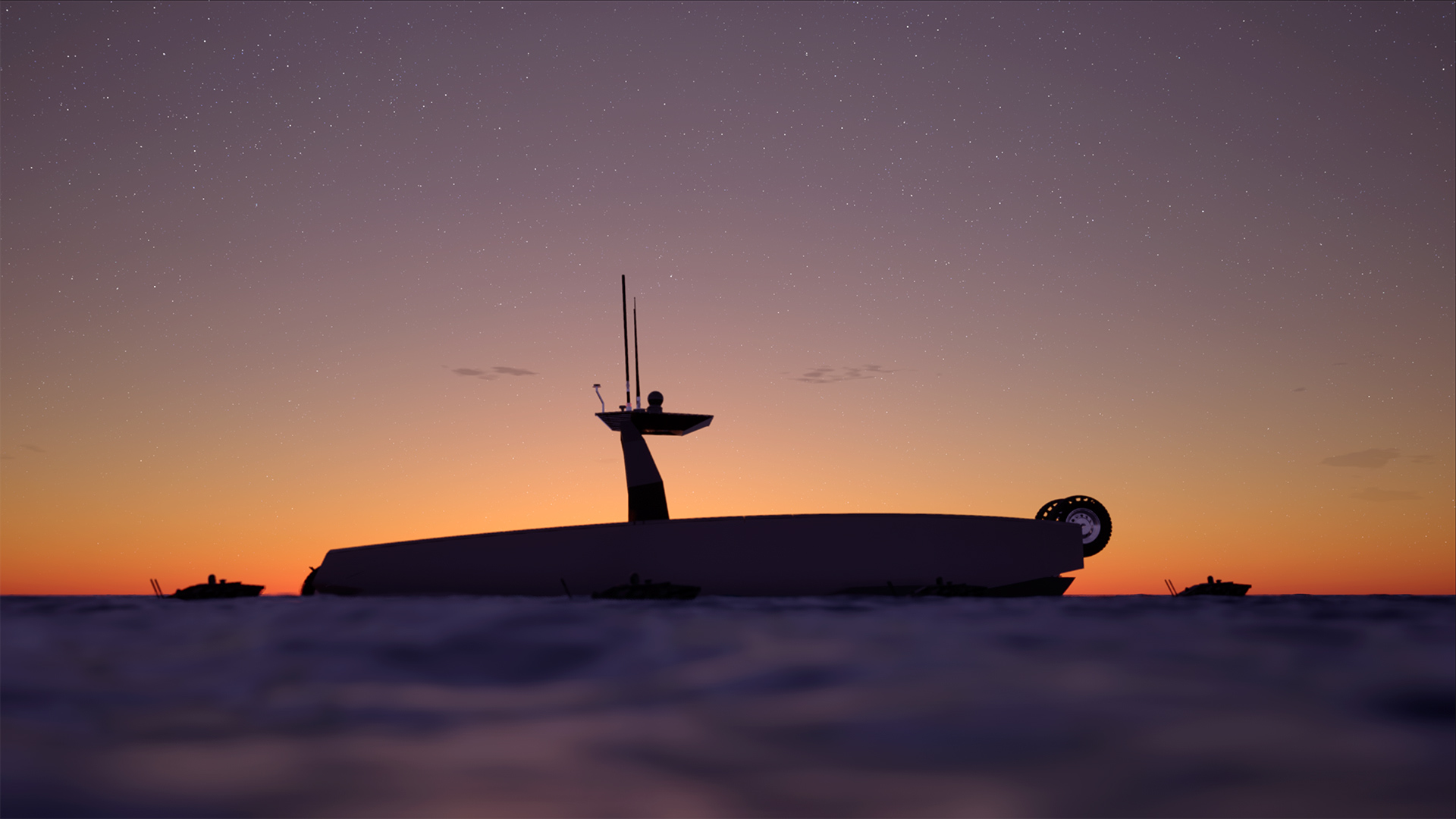
[RYAN ROBERTSON]
ALL RIGHT, FOLKS, IT’S TIME ONCE AGAIN FOR OUR WEAPON OF THE WEEK THIS WEEK AND WE HAVE A DOOZY. I AM STANDING IN FRONT OF THE PROWLER. IT’S MADE BY METAL SHARK. AND JOINING ME TO TALK ABOUT THIS THING IS THE PRESIDENT, CEO OF METAL SHARK. CHRISTOPHER ALLARD. CHRIS, THANKS SO MUCH FOR JOINING US TODAY. THE PROWLER TELL ME ABOUT THIS THING.
[CHRISTOPHER ALLARD]
YEAH, IT’S, IT’S A PRETTY COOL PRODUCT. SO WE LAST FIVE OR SIX YEARS, WE’VE BEEN WORKING ON AUTONOMOUS VESSELS, DIFFERENT COAST GUARD, NAVY MARINE CORPS. LEARNED A LOT AND WANTED TO TAKE AN OPPORTUNITY TO DEVELOP SOMETHING. IT REALLY WASN’T TARGETED AT A SPECIFIC SET OF REQUIREMENTS. THAT WAS YOU KNOW, WE COULD TAILOR IT TO WHAT WE THOUGHT SOME OF THE OPTIONS COULD BE DONE.
A COUPLE OF THINGS ABOUT HER, SHE’S ABOUT 30 FEET LONG, INBOARD DIESEL POWERED, BUT ALSO AUTONOMOUS. SHE HAS A SELF-POWERED FRONT WHEEL THAT ALLOWS HER TO KIND OF CLIMB A RAMP AND MOVE AROUND A BASE THREE TO FIVE MILES AN HOUR. NOT LONG RANGE, JUST GETTING IN AND OUT OF THE WATER ON ITS OWN. AND THEN THE FRONT WHEEL RETRACTS AND THE REAR WHEELS ARE OVER THE ROAD HIGHWAY RATED. IT IS ITS OWN TRAILER, WE LEARNED A LOT IN THE USV SPACE ABOUT HOW HARD IT IS SOMETIMES IN A USV MISSION, WHEN IT STARTS AT LOCATION A MOVES TO LOCATION B AND IT DIDN’T BRING ITS OWN TRAILER, DIDN’T BRING ITS OWN SUPPORT SYSTEM. SO WORKING TO TRY AND GET IT TO BE SELF SUFFICIENT IN THOSE KIND OF APPLICATIONS.
IT’S ALSO SEMI-SUBMERSIBLE, OKAY, UM, IT WASN’T IN THE ORIGINAL DESIGN BRIEF, BUT ONE OF MY ENGINEERS AND I WERE LOOKING AT IT, AND WE REALLY REALIZED THAT IT WASN’T THAT HARD. AND EFFECTIVELY THE BOATS ARE A BOAT IN A BOAT, IF YOU WILL, THERE’S A BOX IN THE MIDDLE. THE BOX IS WATERTIGHT CARRIES THE ENGINE, THE FUEL, THE AUTONOMY SYSTEMS, ALL THE THINGS THAT IT TAKES TO OPERATE. AND THEN THE OUTER PART OF THE BOAT IS BASICALLY TANKS FREE TO FLOOD.
SHE OPERATES AT SPEED LIKE A NORMAL BOAT, BUT WHEN SHE STOPS, SHE KIND OF AUTOMATICALLY INGESTS WATER INTO THESE TANKS. CREATES A LOWER PROFILE, WHICH, YOU KNOW, CERTAIN APPLICATIONS IS NICE FROM A VISIBILITY OR LACK OF PERSPECTIVE. BUT ALSO IT MAKES THEM MORE SEA KINDLY ON STATION, RIGHT. SO THE EXTRA WATER IS ADDED MASS DAMPENING. SO IT KEEPS THE BOAT MORE STABLE FOR BOTH THE SENSORS AND THEN ALSO FOR SURVIVABILITY IN KIND OF HIGHER SEA STATES THAT IT MIGHT HAVE TO LIVE THROUGH. SO YEAH, THOSE ARE OUR PRIMARY FEATURES.
[RYAN ROBERTSON]
YOU BET. AND WE HAVE A, YOU KNOW, KIND OF A DEMONSTRATOR. YEAH, MICRO USV UP HERE. AND THAT’S REALLY YOU WERE SAYING TO JUST KIND OF DEMONSTRATE THE CAPABILITIES THAT THE PROWLER COULD DO, RIGHT?
[CHRISTOPHER ALLARD]
YEAH, I MEAN, CERTAINLY THE THE MATURITY LEVEL OF PROWLER AND WHAT WE PUT INTO THAT IS FURTHER ALONG THAN A MICRO USV. BUT YOU KNOW, WE’VE SEEN WITH OUR CLIENTS, YOU KNOW, THE WORD ATTRITABLE, IS TALKED ABOUT A LOT. AND I THINK AS THE MARKET GOES FORWARD, ATTRITABLE WILL CONTINUE TO GET SMALLER AND CHEAPER. AND WE WANTED TO KIND OF DEMONSTRATE THAT THAT’S AVAILABLE COMMERCIALLY. BUT THEN ALSO, YOU KNOW, LAUNCH AND RECOVERY IS SUCH A BIG THING. AND YOU KNOW, THE RAMP WAS A KEY PART OF WHAT WE WANTED TO DO. AND WE WANTED TO TEST TO SEE AS OPPOSED TO THESE LAUNCH AND RECOVERY CAPTURE METHODS, WHICH ARE REALLY CHALLENGING, CAN WE JUST DRIVE IT UP ON THE BOAT? AND SO THAT’S KIND OF A, YOU KNOW, A DEMONSTRATOR FOR THAT. SHE’S CERTAINLY YOU KNOW, THAT ONE, IF YOU TAKE HER APART, THERE’S EVERYTHING THAT NEEDS TO BE IN IT ISN’T. BUT WHAT WE’RE, WE’RE JUST SHOWING WHAT WHAT OUR THOUGHT PROCESS IS SO.
[RYAN ROBERTSON]
YOU BET YOU BET. SO YOU SAID YOU’RE YOU’RE WORKING WITH MARINES AND THE NAVY RIGHT NOW. IT’S THERE’S NO CONTRACTS YET BUT YOU’RE WORKING TO HOPEFULLY GET TO THAT POINT. IS THAT CORRECT?
[CHRISTOPHER ALLARD]
WE STILL HAVE AN ONGOING CONTRACT WITH THE MARINES IN SUPPORT OF THE LR USV WE’RE CERTAINLY AT THE TAIL END OF IT, YOU KNOW, THE BOATS HAVE BEEN FIELDED THE MARINES HAVE BEEN OPERATING THEM. BUT YOU KNOW, THAT THAT ONE’S STILL ONGOING.
[RYAN ROBERTSON]
OKAY, YOU BET. WHAT’S NEXT FOR PROWLER? WHAT’S THE FUTURE?
[CHRISTOPHER ALLARD]
YOU KNOW, I MEAN, PART OF COMING HERE AND DOING WHAT WE’RE DOING WITH IT TO THIS IN A COUPLE OF SHOWS IS TO GET FEEDBACK, SEE WHAT IDEAS HIT HOME, WHAT DON’T. UNDERSTAND WHAT PEOPLE ARE TRYING TO DO. YOU KNOW, WE ARE MOVING INTO KIND OF DEVELOPING OUR OWN COMMAND AND CONTROL SYSTEM THAT WILL GIVE US THE ABILITY TO CONTROL THEM. THAT’S NOT DONE YET. BUT UM, THAT WOULD BE WHAT WAS WHAT WOULD BE NEXT, YOU KNOW, THE ABILITY TO, WE WANT TO MAKE IT A TURNKEY SOLUTION THAT WILL THEN JUST INTERFACE WITH A SOFTWARE ONLY WITH AUTONOMY PROVIDERS, UAV PROVIDERS, AUTOMATIC TARGET RECOGNITION PROVIDERS. THAT’S NOT OUR SPACE, BUT WE CAN PROVIDE THE HOST SYSTEM THAT MAKES THEM READY TO READY TO DO THAT WITH A SOFTWARE UPDATE, THAT KIND OF THING. SO THAT’S OUR GOAL.
[RYAN ROBERTSON]
SO THIS IS THE PROWLER FROM METAL SHARK, ONE OF THE MORE EYE CATCHING USVS OUT THERE ON THE MARKET TODAY. AND WITH THE NEED THAT THE NAVY AND MARINE CORPS HAVE FOR MORE SURFACE VESSELS, I CAN IMAGINE YOU’LL BE SEEING MORE OF THESE ON THE WATER VERY SOON.







